Papers by Darshini Mahadevia

This paper describes the very large numbers of low-income households displaced by development or ... more This paper describes the very large numbers of low-income households displaced by development or infrastructure projects in Ahmedabad and their relocation by city government to housing on resettlement sites. It discusses the involvement of the Mahila Housing SEWA Trust (MHT) in setting up the required resident welfare associations (RWAs) in eight of these resettlement sites and the difficulties MHT faced in getting residents to follow the many time-consuming procedures that were necessary. Constraints included distrust by residents of the government agencies and the lack of social networks or leadership structures in the resettlement sites resulting from the housing allocation process, which did not keep neighbours or communities together. The city government's objective for the RWAs was not to support participatory governance or facilitate improvements in the lives of resettled dwellers but to pass on the costs, maintenance and management responsibilities of the resettlement sites to these associations.
The trend of involving private sector in affordable housing segment is observed globally. In Indi... more The trend of involving private sector in affordable housing segment is observed globally. In India, it has been mainstreamed through the Pradhan Mantri Awas Yojana (PMAY) under which one component deals with in-situ slum redevelopment through the public-private partnership (PPP) mode in which the private sector brings in finance and skills to construct housing while the public sector provides land. Taking case study of one slum site, wherein the slum rehabilitation scheme has been implemented in Ahmedabad, this article narrates the bottlenecks faced in its implementation in spite of the agency of an NGO involved as a mediator in the process.
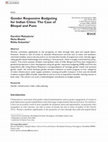
Environment and Urbanization Asia, 2019
Women contribute significantly to the prosperity of cities through their paid and unpaid labour. ... more Women contribute significantly to the prosperity of cities through their paid and unpaid labour. However, limited or lack of access to essential infrastructure services such as water and sanitation, restricted mobility, tenure security and so on increase their burden of unpaid care work, thereby aggravating gender-based disadvantage and resulting in 'time poverty', which is largely overlooked by policy-makers. This article assesses whether metropolitan cities of India, Bhopal and Pune have integrated a gendered perspective in their development using the gender responsive budgeting (GRB) tool from the expenditure side. Using Maxine Molyneux's conceptualization of 'strategic gender needs' and 'practical gender needs', the article develops gender-sensitive indicators to assess progress on four categories of urban infrastructure: water supply, sanitation, housing and public transport. It then uses the benefit incidence analysis (BIA) of public expenditure tool to arrive at expenditure benefits reaching women in both cities. This article is as much a methodological contribution as budget analysis.
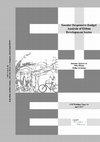
This paper is an exploration in applying methodology of Gender Responsive Budgeting (GRB) to the ... more This paper is an exploration in applying methodology of Gender Responsive Budgeting (GRB) to the urban sector at the city level. It is as much a methodological paper as it is application of gender lens to the urban development processes. The study, borrowing from available methods, has developed a methodology suitable for the analysis of the urban sector finances in India from the gender lens. The analytical framework for assessing the relevance of public expenditures from gender lens is that of Maxine Molyneaux’s ‘Practical and Strategic Gender Needs’. Four sub-sectors within the city, water, sanitation, housing and public transportation, have been assessed through parameters and indicators in each of the sector. Benefit incidence analysis approach has been undertaken to measure the indicators followed by the apportioning of actual expenditures in each of the sub-sector between men and women in the two case study cities of Bhopal and Pune.

AbstrAct This paper describes the very large numbers of low-income households displaced by develo... more AbstrAct This paper describes the very large numbers of low-income households displaced by development or infrastructure projects in Ahmedabad and their relocation by city government to housing on resettlement sites. It discusses the involvement of the Mahila Housing SEWA Trust (MHT) in setting up the required resident welfare associations (RWAs) in eight of these resettlement sites and the difficulties MHT faced in getting residents to follow the many time-consuming procedures that were necessary. Constraints included distrust by residents of the government agencies and the lack of social networks or leadership structures in the resettlement sites resulting from the housing allocation process, which did not keep neighbours or communities together. The city government's objective for the RWAs was not to support participatory governance or facilitate improvements in the lives of resettled dwellers but to pass on the costs, maintenance and management responsibilities of the resettlement sites to these associations. KeyworDs Ahmedabad / Basic Services to the Urban Poor (BSUP) / community development / Mahila Housing SEWA Trust (MHT) / mobilization / resettlement / resident welfare association (RWA)

AbstrAct This paper describes the very large numbers of low-income households displaced by develo... more AbstrAct This paper describes the very large numbers of low-income households displaced by development or infrastructure projects in Ahmedabad and their relocation by city government to housing on resettlement sites. It discusses the involvement of the Mahila Housing SEWA Trust (MHT) in setting up the required resident welfare associations (RWAs) in eight of these resettlement sites and the difficulties MHT faced in getting residents to follow the many time-consuming procedures that were necessary. Constraints included distrust by residents of the government agencies and the lack of social networks or leadership structures in the resettlement sites resulting from the housing allocation process, which did not keep neighbours or communities together. The city government's objective for the RWAs was not to support participatory governance or facilitate improvements in the lives of resettled dwellers but to pass on the costs, maintenance and management responsibilities of the resettlement sites to these associations. KeyworDs Ahmedabad / Basic Services to the Urban Poor (BSUP) / community development / Mahila Housing SEWA Trust (MHT) / mobilization / resettlement / resident welfare association (RWA)

In the context of growing disenchantment with modern technologies in agriculture, it is often arg... more In the context of growing disenchantment with modern technologies in agriculture, it is often argued that the grassroots innovations play a significant role in rural development in general and improving agricultural productivity and incomes of farmers in particular. But our understanding on the institutional architecture needed for promoting grassroots innovations in developing countries like China at best remain rudimentary. The present paper address this issue by an analysis of the institutional arrangements evolved overtime for the promotion of GRIs in Hua County and its outcomes in terms of increased number of patents and their commercialisation. The study highlights the constructive role of the triad of governance, the CPPCC, along with the CPC and the government in the observed performance in the sphere of GRIs. The case study also shows that there is a fourth pillar in the institutional architecture for the promotion of GRIs. This is manifested in the formation of the Association of Inventors as an NGO nurtured by the Government. The analysis in the paper therefore, highlights the significant role of institutions in general as well as the coevolution of institutions with changing environment to promote innovations and their commercialisation.
In high growth economies, continuous rural to urban migration has put forth a large challenge for... more In high growth economies, continuous rural to urban migration has put forth a large challenge for the housing planners. In particular, China has witnessed much higher rate of rural to urban migration and hence provides an interesting case for research. In India, rural to urban migrants are at great disadvantage with regard to housing and access to basic services. This article is a comparative research on housing conditions and mobility of the migrants in urban areas in China and India, based on data collected from one city each in each country—Surat in India and Dongguan in China. The article focuses on identifying the housing sub-markets accessed by the migrants in both the cities and the process of access to the same, studying the living conditions of the migrants in both the cities and discussing the policy implications of the existing situation.
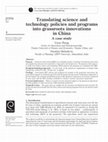
Purpose – Grassroots innovations (GRIs) can contribute greatly to inclusive development and reach... more Purpose – Grassroots innovations (GRIs) can contribute greatly to inclusive development and reach out populations and areas not reached by or ignored by the formal sector. The purpose of the paper is to study how China's science and technology (S&T) policies and programs are translated into GRIs. Design/methodology/approach – A case study of the grassroots organizations of farmer Chen Guangxing, of Baodi County, Tianjin City, is applied. Findings – Government S&T policies and programs do transfer to the grassroots innovators; the government support is continuous and all-round; the grassroots innovators' leadership is important to get the support; the research and diffusion projects that grassroots innovators received are integrated in some cases; and the S&T training contributes to farmers' research and project application. Practical implications – There is a need to increase financial support to the grassroots innovators, provide guidance to them and set up a GRI reporting mechanism. Originality/value – The paper gives an insight into the synergies and illustrates how and why the grassroots innovators benefit from the laws, policies and ensuing programs that are not directly meant for them.
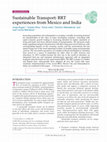
Increasing population and urbanization is creating a steadily increasing demand for transportatio... more Increasing population and urbanization is creating a steadily increasing demand for transportation in the cities of many developing countries, coinciding with rapid economic growth leading to increasing demand for higher standards of living and faster and more efficient modes of transportation. The decisions made today regarding transport infrastructure will affect long-term travel behavior, with corresponding impacts on the economy, society, and the environment, the last impact being one of the most important in times of steadily rising environmental concern. The successful experiences of Curitiba in Brazil and Bogotá in Colombia have served as a source of inspiration for other cities in Latin America and elsewhere. In 1973 Curitiba became the first city in the world to introduce an integrated land use and transport infrastructure approach with an integrated transport network based on bus rapid transit (BRT). The BRT systems of Curitiba and Bogotá have subsequently been adopted all over the world with some variations. Implementation of two recent BRTs, Mexico City and Ahmedabad in India, are examined in this paper.

AbstrAct This paper describes the very large numbers of low-income households displaced by develo... more AbstrAct This paper describes the very large numbers of low-income households displaced by development or infrastructure projects in Ahmedabad and their relocation by city government to housing on resettlement sites. It discusses the involvement of the Mahila Housing SEWA Trust (MHT) in setting up the required resident welfare associations (RWAs) in eight of these resettlement sites and the difficulties MHT faced in getting residents to follow the many time-consuming procedures that were necessary. Constraints included distrust by residents of the government agencies and the lack of social networks or leadership structures in the resettlement sites resulting from the housing allocation process, which did not keep neighbours or communities together. The city government's objective for the RWAs was not to support participatory governance or facilitate improvements in the lives of resettled dwellers but to pass on the costs, maintenance and management responsibilities of the resettlement sites to these associations. KeyworDs Ahmedabad / Basic Services to the Urban Poor (BSUP) / community development / Mahila Housing SEWA Trust (MHT) / mobilization / resettlement / resident welfare association (RWA)
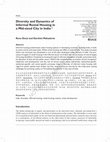
Informal housing predominates urban housing options in developing countries, including India, in ... more Informal housing predominates urban housing options in developing countries, including India, in both its metro and its mid-sized cities. Within urban housing, two-fifths is rental in India. This study is located within one mid-sized city (Guwahati) in one of the least developed states (Assam) in India. The processes of supply of rental housing in the informal sector are linked with the processes of overall supply of housing identified in Guwahati as housing through (i) informal occupation of public and private lands, (ii) alienation of land and (iii) public sector. Within that, landownership, processes of land occupation/ subdivision and development, and the role of various actors create submarkets. Submarket-specific, settlement-specific and owner-specific processes shape a diversity of informal rental housing with regard to extent, quality, level of basic services, rents and tenure security for the urban poor, posing challenges for pursuing a policy of 'formalizing the informal' in the case of India.

AbstrAct This paper describes the very large numbers of low-income households displaced by develo... more AbstrAct This paper describes the very large numbers of low-income households displaced by development or infrastructure projects in Ahmedabad and their relocation by city government to housing on resettlement sites. It discusses the involvement of the Mahila Housing SEWA Trust (MHT) in setting up the required resident welfare associations (RWAs) in eight of these resettlement sites and the difficulties MHT faced in getting residents to follow the many time-consuming procedures that were necessary. Constraints included distrust by residents of the government agencies and the lack of social networks or leadership structures in the resettlement sites resulting from the housing allocation process, which did not keep neighbours or communities together. The city government's objective for the RWAs was not to support participatory governance or facilitate improvements in the lives of resettled dwellers but to pass on the costs, maintenance and management responsibilities of the resettlement sites to these associations. KeyworDs Ahmedabad / Basic Services to the Urban Poor (BSUP) / community development / Mahila Housing SEWA Trust (MHT) / mobilization / resettlement / resident welfare association (RWA)
R e g i o n a l O f f i c e f o r A s i a a n d t h e P a c i f i c I L O A s i a-P a c i f i c W... more R e g i o n a l O f f i c e f o r A s i a a n d t h e P a c i f i c I L O A s i a-P a c i f i c W o r k i n g P a p e r S e r i e s Decent work i n A hmedabad : A n i ntegrated approach D W T f o r S o u t h A s i a a n d C o u n t r y O f f i c e f o r I n d i a
Recent statistics show the majority of workers in developing countries earn their livelihoods in ... more Recent statistics show the majority of workers in developing countries earn their livelihoods in the informal economy. The Informal Economy Monitoring Study (IEMS) is a qualitative and quantitative study designed to evaluate the reality of informal livelihoods. With research conducted over multiple years in 10 cities, the IEMS aims to provide credible, grounded evidence of the range of driving forces, both positive and negative, that affect conditions of work in the informal economy over time. Informal workers and their membership-based organizations (MBOs) are at the centre of the analysis.
Recent statistics show the majority of workers in developing countries earn their livelihoods in ... more Recent statistics show the majority of workers in developing countries earn their livelihoods in the informal economy. The Informal Economy Monitoring Study (IEMS) is a qualitative and quantitative study designed to evaluate the reality for these workers' lives. With research conducted over multiple years in 10 cities, the IEMS aims to provide credible, grounded evidence of the range of driving forces, both positive and negative, that affect conditions of work in the informal economy over time. Informal workers and their membership-based organizations (MBOs) are at the centre of the analysis.








Uploads
Papers by Darshini Mahadevia